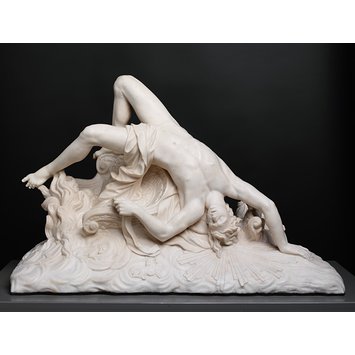
The Fall of Phaeton
- Object:
Statue
- Place of origin:
France (made)
- Date:
ca. 1700 - ca. 1711 (made)
- Artist/Maker:
Lefevre, Dominique (sculptor)
- Materials and Techniques:
Carved white marble
- Museum number:
A.4-1958
- Gallery location:
In Storage
In his narrative mythological poem The Metamorphoses, the Roman poet Ovid
describes how Phaeton ascended into heaven, the home of his suspected father the
Sun (aka Phoebus or Helios). Helios swore by the river Styx to give Phaeton
anything he should ask for in order to prove his divine paternity. In response,
Phaeton asked to drive his father's chariot (the sun) for a day. Helios tried to
talk him out of it, but Phaeton was adamant. When the day came, Phaeton was
unable to control the fierce horses that drew the chariot. He got so close to
the Earth that it was scorched. Zeus (Jupiter) intervened and struck Phaeton off
the chariot with a thunderbolt. Phaeton fell to the ground.
It is this dramatic moment that Lefèvre has chosen to depict, with Phaeton falling headfirst, his body arching up and backwards. The composition is derived from a known Roman sarcophagus depicting the same subject. Showing a single figure in an extreme pose was a convention for 'morceaux de reception' or 'reception pieces' demanded of artists before they were allowed to become members of the Académie Royale de Peinture et de Sculpture (Royal Academy) and so be able to receive royal commissions, so this may have been a similar academic exercise. Certainly we know that Lefèvre was active between 1698 and 1709 working for the King, Louis XIV, producing sculpture for the gardens at Trianon, the park at Marly, and the chapel at Versailles.
It is this dramatic moment that Lefèvre has chosen to depict, with Phaeton falling headfirst, his body arching up and backwards. The composition is derived from a known Roman sarcophagus depicting the same subject. Showing a single figure in an extreme pose was a convention for 'morceaux de reception' or 'reception pieces' demanded of artists before they were allowed to become members of the Académie Royale de Peinture et de Sculpture (Royal Academy) and so be able to receive royal commissions, so this may have been a similar academic exercise. Certainly we know that Lefèvre was active between 1698 and 1709 working for the King, Louis XIV, producing sculpture for the gardens at Trianon, the park at Marly, and the chapel at Versailles.





No comments:
Post a Comment